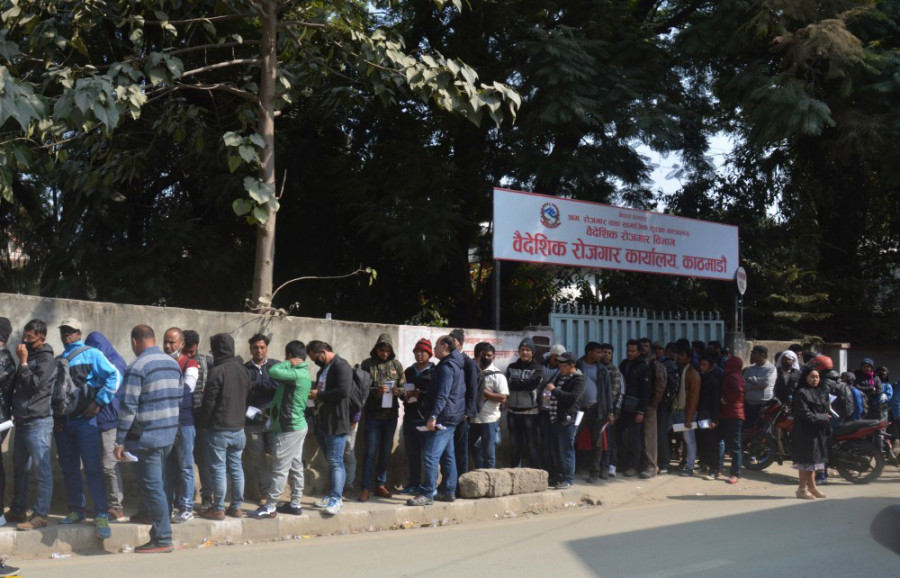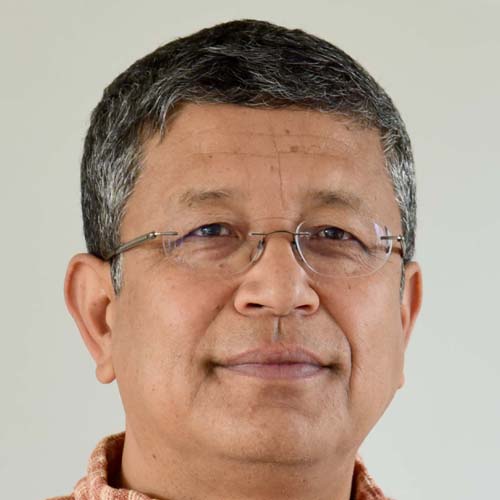Columns
Nationalism, migration and the impending job crisis
Communist parties have always disliked the idea of out-migration yet have done little to help Nepalis stay back.
Deepak Thapa
The idea of Nepalis working in foreign countries has always been anathema to our communist parties. The 1949 manifesto, the very first from the newly formed Communist Party of Nepal, had called on Nepali women to demand the return of ‘our sons and husbands in foreign imperialist armies’, the last being a reference to both British and Indian. While the call for the end of Gurkha recruitment became a staple over the decades, with the advent of the changing labour market in the 1990s and the rise of foreign employment, that unease soon metamorphosed into a sense of indignity that Nepalis had to work in other countries.
Unfortunately, apart from cosmetic moves here and there, little was done to end that situation and we got caught increasingly into the remittance-dependent trap that many countries before us had found themselves in. For, reversing the flow of workers requires visionary leadership to create competitively remunerative employment in the country. Yet, all we have got over the years are a bunch of stirring speeches about the need to build our country and nothing else.
That became most evident after the 2015 earthquake, when those running the state, including Prime Minister KP Oli in his first stint at the top job, spoke in rousing terms of calling on the expertise of Nepalis spread around the world to help rebuild the country. That our politicians found the time, in the midst of the devastation all around them and the imperative of drafting a new constitution, to haggle over and delay the establishment of the National Reconstruction Authority by more than half a year after the earthquake says a lot about where their actual priorities lay. The idea of reaching out to expatriate Nepalis remained only that—cheap talk infused with a good dose of nationalism.
Return to nationalism
Once the Nepal Communist Party (NCP) came to power in 2017-18, it was no surprise to see nationalism making a comeback, particularly since it fit in neatly with its election promise slogan of stability and prosperity. Given that foreign employment had never sat so easily with the nationalist discourse, the sector was expected to be affected in one way or another. Thus, it was announced that the Foreign Employment Promotion Board would be provided with a mandate different from just promoting employment abroad. But when the name change actually took place in March 2019, apart from dropping ‘promotion’ to become the Foreign Employment Board, absolutely nothing denoted that the Board’s original role of promoting foreign employment had changed. That was so typical of this government—high on rhetoric; nothing on action.
The irony is that the former Maoists who are now part of the current dispensation themselves were partly responsible for the rapid rise of foreign employment as a livelihood strategy. Records with the government showing the number of labour permits issued for those seeking employment in countries other than India began in 1993-94, with 3,605 permits issued that year. In 1996-97, the year the insurgency began, there were actually fewer labour permits handed out: 3,259. In 1997-98, figures had crept up to 7,745, and the next year, coinciding with the infamous Kilo Sierra Two police mop-up operations against the Maoists, the numbers rose nearly four-fold, to 27,796. In 1999-00 and 2000-01, a few thousand more were added, to reach 35,543 and 55,025, respectively. And, in 2001-02, with the escalation of the fighting after the army was pulled into the conflict, the numbers doubled to 104,736; we have not looked back since.
If the Maoist conflict was a major push factor, its impact was amplified by the government’s own actions. As the migration scholar, Jagannath Adhikari, reminds us, in the course of the Ninth Plan period (1997–2002) ‘the government developed two policies related to the promotion of foreign employment. One was to send 200 workers for foreign employment from each election constituency, numbering 201 constituencies at that time, and the other was to provide a loan of NPR 100,000 to conflict affected and socially excluded groups so that they can take opportunity for foreign employment’. As he writes, policymakers believed they could stem the flow of youths into Maoist ranks by encouraging them to opt for foreign employment. Of course, all that outflow also had the highly unexpected but fortuitous result of lowering poverty rates from 42 percent in 1995-96 to 31 percent in 2003-04, all the years of intense fighting notwithstanding.
Foreign employment figures have continued to tick upwards, with the exception of a dip around the time of the financial crisis in 2008-09, reaching a record of more than 700,000 in 2014-15. The numbers have gone down progressively every year since then. Yet an excess of half a million permits were issued in 2018-19. These are the kind of figures we need to contend with as the country contemplates its next big step vis-à-vis the Covid-19 pandemic. The issue of internal migrants has somehow been resolved, and enough has been written about it to bear repeating here. With the focus now solely on the insufferable conditions migrant workers outside Nepal find themselves in, the clamour to bring them back is not something the government will be able to ignore for long.
Tough task ahead
The main problem facing us right now is that we do not know how many Nepalis are where at the moment, particularly when it comes to labour migrants. Let’s take the example of one of the most popular destinations for Nepali—Qatar. The Nepal Labour Force Survey (NLFS) 2017-18 puts the number at 437,009; one recent source working with figures provided by the Department of Passports said there were 406,917 Nepalis in Qatar in 2018-19; and at a recent parliamentary committee hearing, the Foreign Employment Board provided 351,872 as the number of Nepalis in Qatar at present. These variances are pretty wide but what is clear is that we are dealing with a large number of Nepalis abroad.
In the short term, the main challenge will be how to safely bring back Nepalis and keep them safe. According to the Foreign Employment Board figures cited earlier, there are 127,000 Nepali migrant workers who need to be brought back immediately while, as of May 12, we had a total of 49,490 quarantine beds in all of Nepal. We do not know how many of the 1.2 million Nepalis in India (according to the NLFS) are also trying to get back either. Given this massive shortfall in quarantine facilities, a staggered evacuation of Nepalis abroad seems to be the only way out, and how to make that work well will require careful planning but is still within the realm of possibility.
In the long run, though, the government will have to deal with the immediate consequences of jobs having dried up in destination countries, and further losses as these economies slow down over time. Thus, in a perverse sense, the ruling party will finally have been given a chance to live up to its dream of keeping everyone at home and in the service of the nation. Even without the pandemic, one would have serious doubts whether it would have been up to the challenge. With the ongoing health emergency, that will prove to be an impossibility.
***
What do you think?
Dear reader, we’d like to hear from you. We regularly publish letters to the editor on contemporary issues or direct responses to something the Post has recently published. Please send your letters to [email protected] with "Letter to the Editor" in the subject line. Please include your name, location, and a contact address so one of our editors can reach out to you.




 16.24°C Kathmandu
16.24°C Kathmandu















